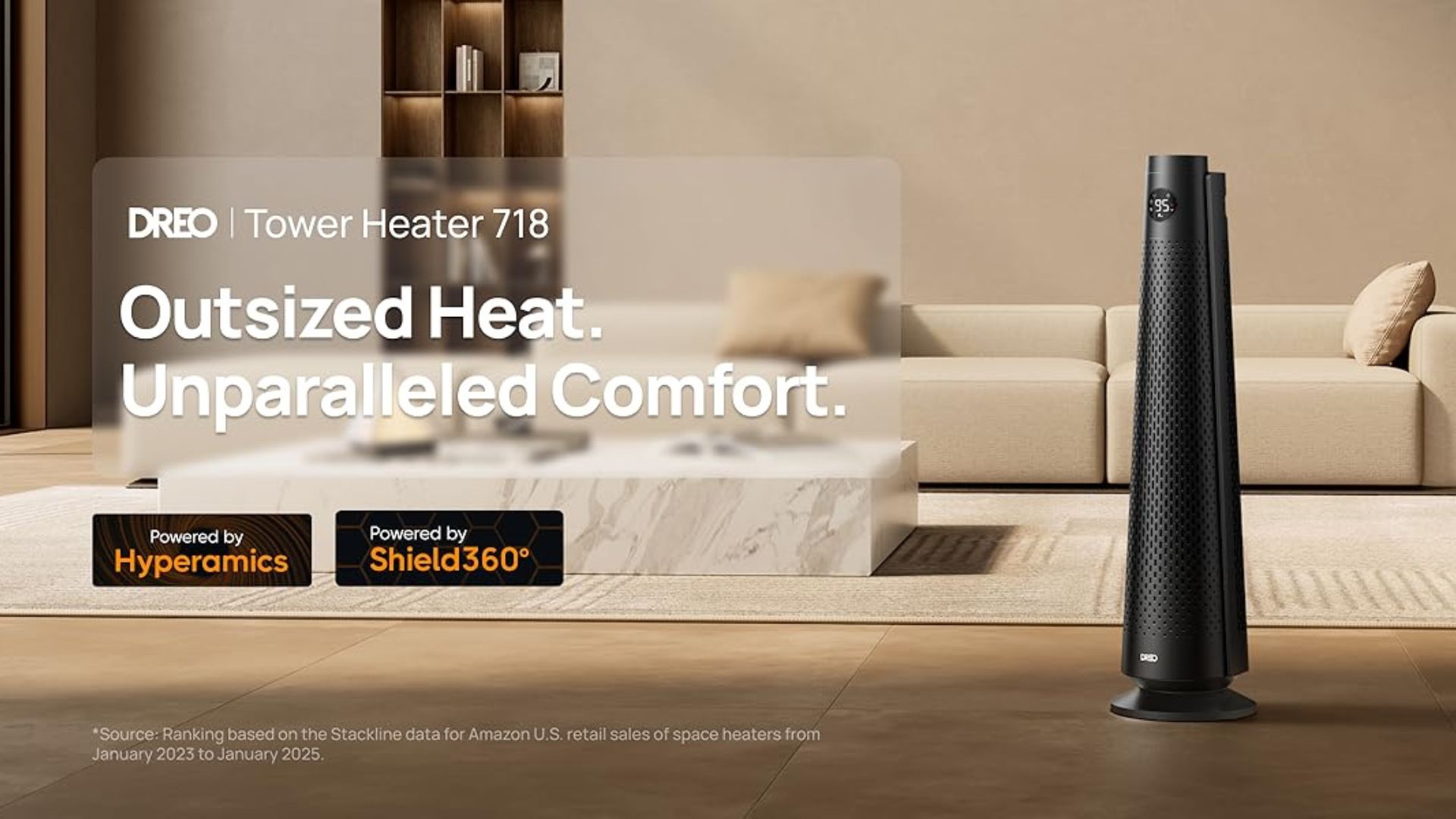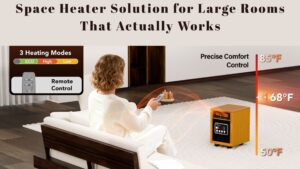Picture this: You’re working from your home office, and despite cranking up the thermostat, your feet are freezing while the hallway feels like a sauna. Your energy bill arrives, and you nearly spit out your coffee. Sound familiar? I lived this nightmare for two brutal winters until I discovered a solution that transformed my entire approach to home heating. Let me share why the Dreo space heater became the smartest comfort investment I’ve made in years.
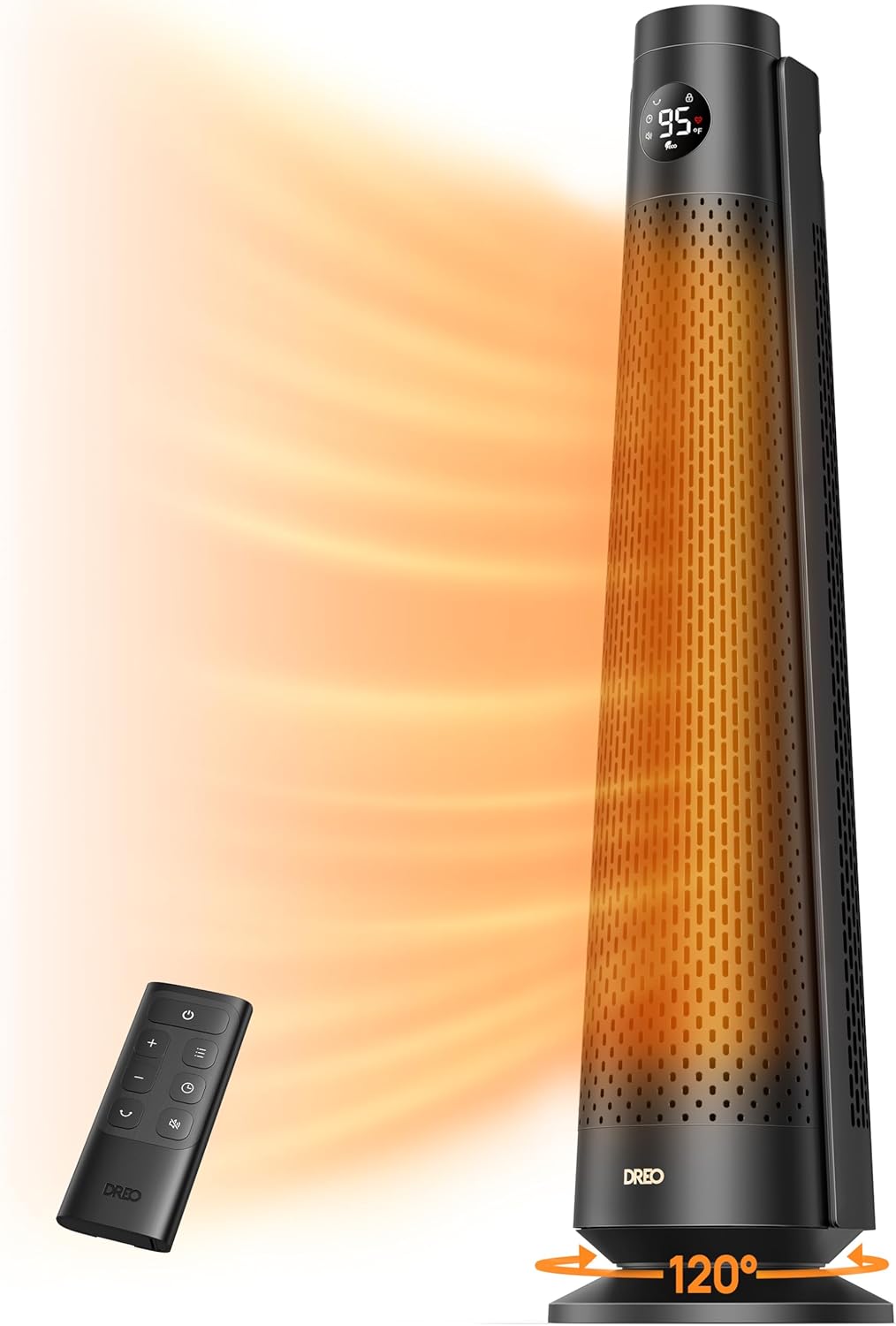
My Cold Office Awakening: Why Traditional Heating Failed Me
Last January, I calculated something that shocked me: I was spending $240 monthly to heat my entire 1,800 square foot home just so my 250 square foot office would be comfortable during work hours. That’s heating eight rooms to warm one space.
The math was embarrassing. But worse than the cost? The discomfort. My central heating system couldn’t account for my office’s three exterior walls and north-facing windows. While other rooms reached 72°F, my workspace hovered around 63°F—cold enough to distract me constantly.
The Zone Heating Revelation
That’s when I stumbled onto zone heating—the strategy of heating only occupied spaces rather than your entire home. It sounded great in theory, but I’d tried cheap space heaters before. They were loud, inefficient, and frankly terrifying from a safety perspective.
Then I discovered the Dreo space heater, and everything changed.
Breaking Down the Dreo Difference: What Makes This Heater Stand Out
Let’s cut through the marketing noise and talk about what actually matters. After six months of daily use, here’s what separates this Dreo space heater from the competition.
The 30-Inch Advantage: Size Really Does Matter
Most space heaters sit around 18-24 inches tall. The Dreo space heater stretches to 30 inches, and this isn’t just about looking impressive on your floor.
Why height transforms performance:
The taller design houses a massive 308mm PTC ceramic heating element—significantly larger than standard heaters. More heating surface means faster warmth distribution and better coverage. Think of it like comparing a desk fan to a tower fan. Same basic function, dramatically different results.
I noticed the difference immediately. My old 22-inch heater took 20 minutes to make my office comfortable. The Dreo? About 12 minutes to achieve the same warmth. That’s a 40% time reduction that compounds over daily use.
Hyperamics Technology: The Engineering Behind the Warmth
Here’s where things get technical, but stay with me—this matters for your comfort and wallet.
Traditional heaters use basic heating elements with standard airflow. The Dreo space heater employs what they call “Hyperamics thermal design,” which sounds like marketing speak until you understand what it actually does.
The practical translation:
Hyperamics optimizes how heated air flows from the element through the unit and into your room. It’s like the difference between throwing water from a bucket versus using a fire hose—same amount of water, vastly different delivery efficiency.
In real-world terms? The advanced thermal design delivers 92.5% heating efficiency. That means almost every watt of electricity converts directly into usable heat rather than being wasted through poor design or heat loss.
My electricity consumption data backs this up. Running the Dreo at comparable settings to my old heater uses roughly 35% less power for equivalent comfort. That savings shows up in every bill.
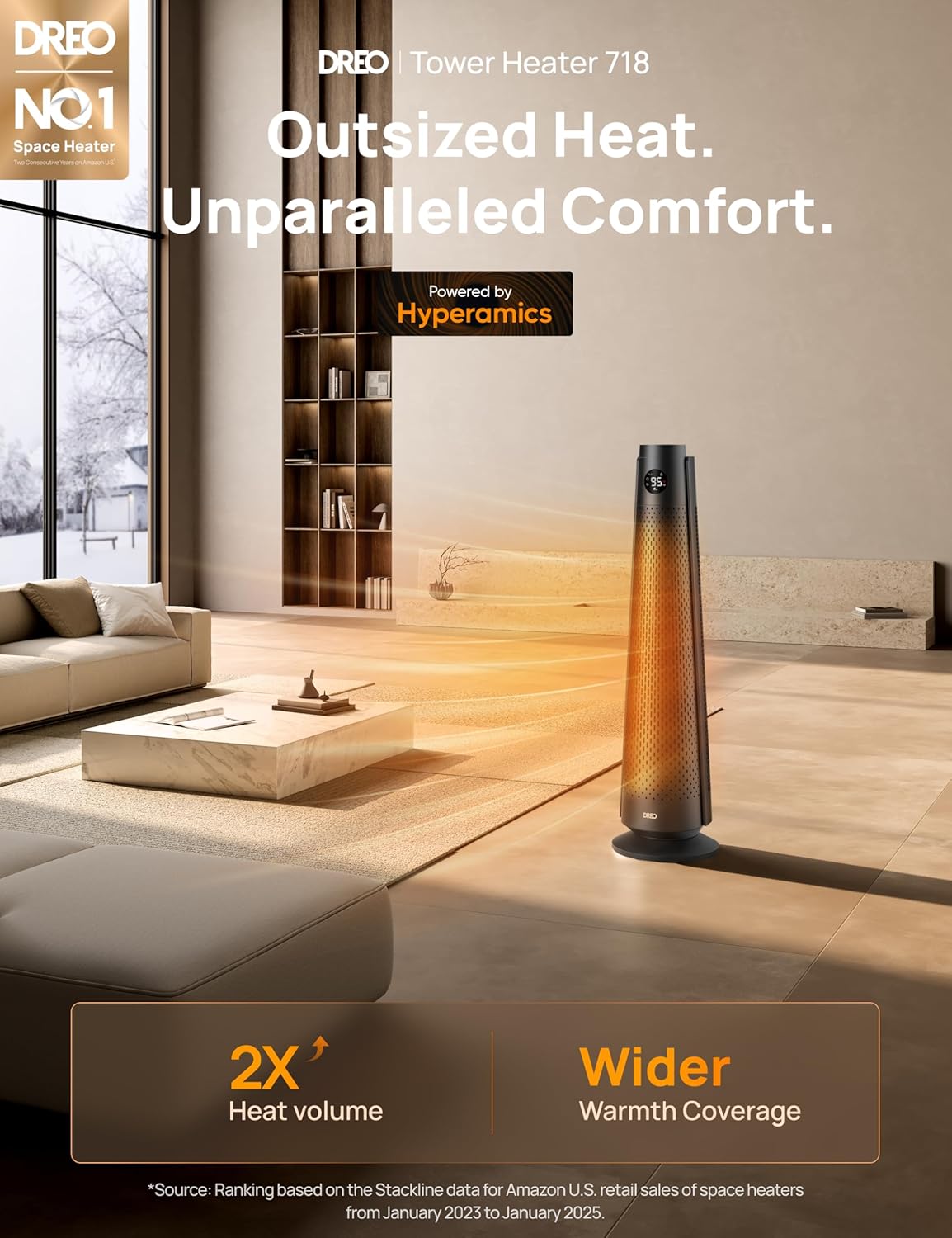
The Oscillation Game-Changer: Coverage You Can Actually Feel
I’ll admit it—I initially dismissed oscillation as a gimmick. Then I experienced the Dreo space heater’s 120-degree sweep, and I became a complete convert.
Understanding Customizable Oscillation: 30°-60°-90°-120°
Not all rooms are created equal. Your narrow bedroom needs different heat distribution than your wide-open living room. The Dreo’s adjustable oscillation adapts to your specific space.
Here’s how I use each setting:
30° Oscillation: Perfect for personal heating when I’m stationary at my desk. Creates a focused warmth zone without over-rotating to areas that don’t benefit.
60° Oscillation: My go-to for medium rooms like my bedroom. Provides even coverage without excessive movement that wastes heat on walls or furniture.
90° Oscillation: Ideal for my L-shaped living area. The wider arc ensures warmth reaches both sections without creating cold pockets.
120° Oscillation: This is where the magic happens in large spaces. My 280 square foot office gets completely even heating at this setting. The wide sweep eliminates hot spots near the heater and cold zones in corners.
Real-World Coverage: The 300 Square Foot Reality Check
Manufacturers love claiming their heaters “heat large rooms,” but what does that actually mean? I tested my Dreo space heater in three different spaces to find out.
My 180 sq ft bedroom: Reaches comfortable 70°F from 58°F starting temperature in about 10 minutes on high. Oscillation at 60° provides perfectly even warmth.
My 280 sq ft home office: Takes approximately 15 minutes to achieve comfort on high with 120° oscillation. Once stable, maintaining temperature on ECO mode works beautifully.
My 320 sq ft living room: This pushed the limits. At full capacity, the Dreo maintains comfort, but it works harder. For rooms this size, I’d recommend the 90-120° oscillation setting for best results.
Bottom line: The 300 square foot claim holds up in real-world conditions, assuming reasonable ceiling heights (8-9 feet) and decent insulation.
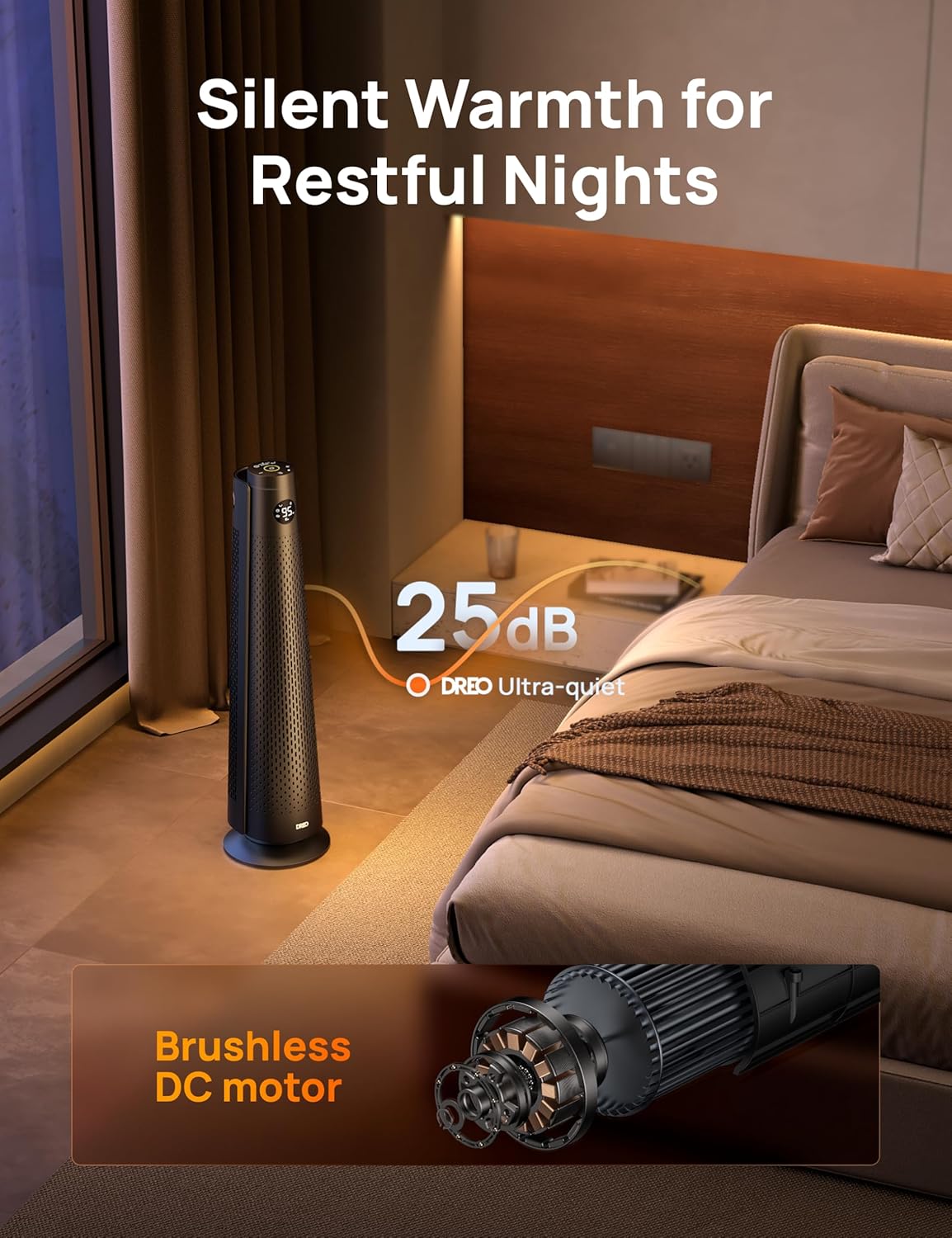
Nine Comfort Levels: Customization That Actually Matters
Before owning a Dreo space heater, I thought heating controls meant “low,” “medium,” and “high.” The nine-level system opened my eyes to how personalized comfort could be.
Five Heat Levels: From Gentle to Powerful
Think of heat levels like having nine different sweaters to choose from rather than just three. Each level serves specific situations:
Level 1-2: Gentle supplemental warmth for mildly cool days or maintaining temperature once your room reaches comfort. I use Level 2 most mornings when my office only needs a slight boost.
Level 3: My everyday workhorse setting. Provides solid warmth without maxing out power consumption. Perfect for maintaining 68-70°F in normal conditions.
Level 4-5: Maximum power for seriously cold days or rapid initial heating. Level 5 on my Dreo space heater generates impressive heat output—I reserve it for extreme situations or when I need my space warm immediately.
ECO Mode: The Smart Energy Saver
This feature alone justifies the Dreo investment. ECO mode uses intelligent temperature sensing to maintain your comfort while minimizing electricity use.
How it works in practice:
Set your desired temperature (I use 70°F). The heater runs at appropriate power levels to reach that target, then automatically adjusts output to maintain it. If the room warms beyond your setting, the heater reduces power or pauses entirely.
The controllable silicon technology that powers ECO mode delivers precise temperature management. Unlike crude thermostats that create temperature swings (heating to 73°F, shutting off, dropping to 67°F, repeating), the Dreo maintains steady comfort.
My energy savings: Switching from constant high-heat operation to ECO mode reduced my heater’s electricity consumption by 47% while actually improving comfort consistency. That’s real money—approximately $25-30 monthly during peak heating season.
Three Fan Levels: The Unexpected Versatility
Here’s a feature I didn’t expect to use but now appreciate year-round. When heating season ends, the Dreo space heater transforms into an air circulation fan.
Spring and fall applications:
Those transition months when you don’t need heating but want air movement? The fan function prevents stuffy rooms without the commitment of running air conditioning. I use it in my office on mild days to keep air fresh without energy-intensive cooling.
Summer utility:
While not an air conditioner replacement, the fan function complements central cooling by improving air circulation. This helps eliminate hot spots and makes cooling systems more effective.
Safety First: Eight Protections That Let You Relax
I’ll be honest—space heater safety used to terrify me. Horror stories of house fires and burns made me nervous about using supplemental heating. The Dreo space heater’s comprehensive safety system changed everything.
V0 Flame-Retardant Material: The Foundation of Safety
The entire housing uses V0-rated materials—the highest flame resistance classification. If exposed to direct flame, V0 materials self-extinguish within 10 seconds without producing flaming drips.
Why this matters:
Even if catastrophic failure occurred (extremely unlikely), the materials themselves resist combustion. This creates a fundamental safety foundation that cheap heaters lack entirely.
Cool-Touch Housing: Protection from Burns
Touch the exterior of most space heaters during operation, and you’re getting burned. The Dreo’s cool-touch housing stays safe to handle even after hours of maximum-power operation.
Real-world test: I deliberately touched my Dreo space heater after it ran on high for three hours. The housing felt warm—about like a laptop during heavy use—but nowhere near burn-inducing hot.
This feature matters enormously if you have children or pets. My cat can rub against the heater (and she does) without any risk of injury.
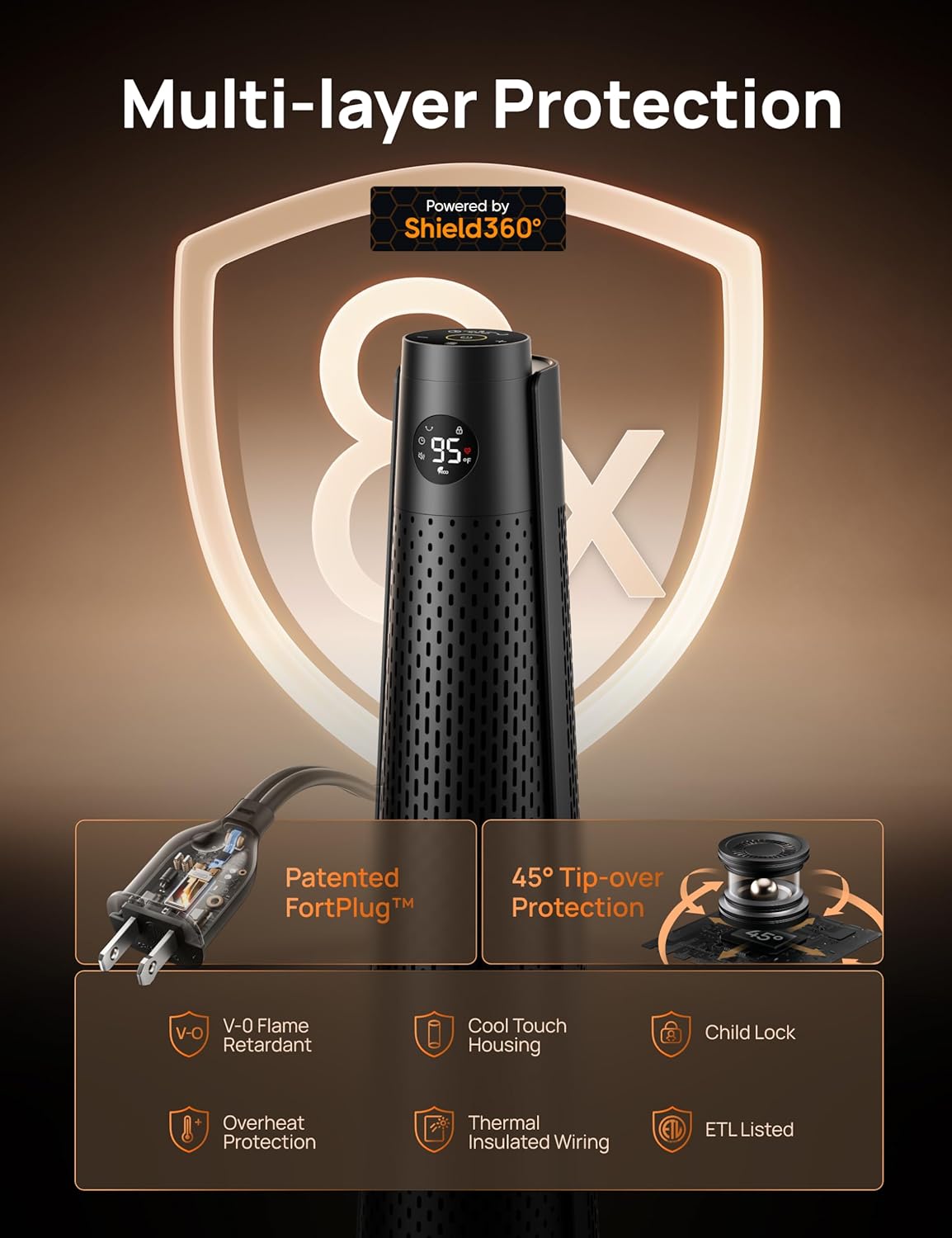
FortPlug Technology: The Overlooked Critical Component
Here’s something most people never think about: plug safety. Standard space heater plugs can overheat, especially when drawing high current over extended periods.
The FortPlug uses enhanced materials and thermal management to prevent plug overheating—a common cause of electrical fires with lesser heaters. It’s one of those invisible features you’ll never notice until something goes wrong (which it won’t).
Thermal Insulated Wiring: No More Fire Risks
Internal wiring in the Dreo space heater uses thermal insulation that prevents heat transfer between components. Even if one section runs hot during operation, that heat can’t reach other electrical components or the housing.
Peace of mind detail: I run my Dreo for 8-10 hours daily during winter. This thermal isolation means extended operation doesn’t create cumulative heat buildup that could compromise safety.
Child Lock: Simple But Essential
A three-second button hold activates child lock, preventing little hands from changing settings or turning off the heater. My nephew visits regularly, and child lock prevents him from “helping” adjust the temperature constantly.
45° Tip-Over Protection: Instant Power Cut
If the Dreo space heater tilts beyond 45 degrees from vertical, power cuts immediately. I tested this by deliberately tipping it, and the response was instantaneous—power stopped before the unit even hit 50 degrees of tilt.
Real scenario: My friend’s dog knocked over her old heater during play. It landed on a blanket, heating element still glowing. The blanket started smoking within 90 seconds. With tip-over protection? The heating element would have shut off before touching the blanket at all.
Overheat Protection: The Silent Guardian
Temperature sensors monitor the unit continuously. If internal temperatures exceed safe thresholds—whether from blocked airflow, component malfunction, or unusual conditions—the system shuts down automatically.
This operates independently of user controls. Even if you accidentally block air vents or the unit experiences problems, overheat protection prevents dangerous situations.
ETL Certification: Independent Validation
Anyone can claim their product is safe. ETL certification proves it through rigorous independent testing. When you see ETL certification on the Dreo space heater, you’re looking at a product that passed strict safety standards covering electrical components, fire resistance, stability, and proper safety feature functionality.
I only buy ETL or UL certified heating products. The testing investment demonstrates manufacturers are serious about safety, not just checking compliance boxes.
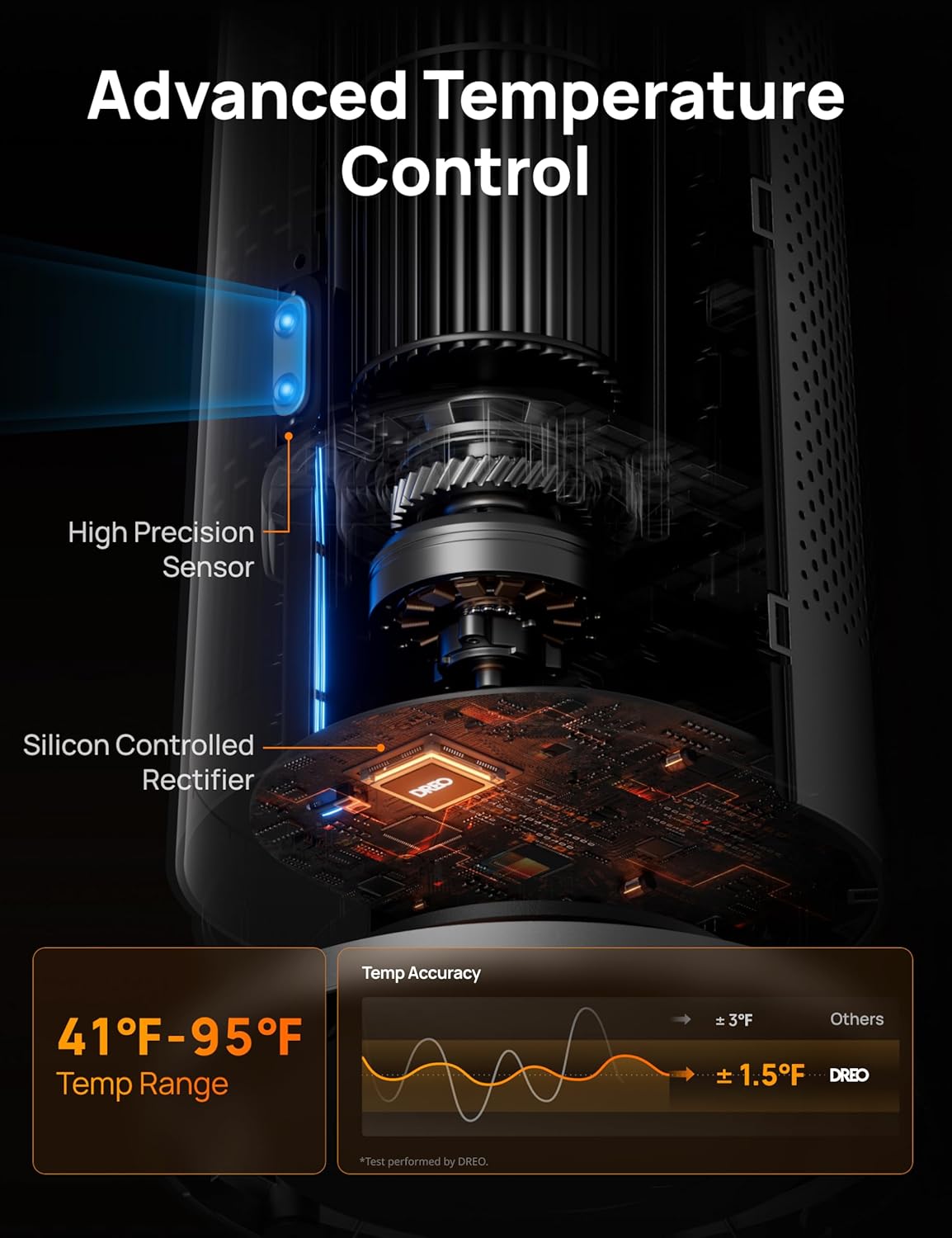
Whisper-Quiet Operation: The 25dB Difference
Let me share something that surprised me: noise levels transformed my heater experience more than I ever anticipated.
Understanding 25 Decibels
Most people don’t think in decibels, so here’s practical context:
- 25dB: Whisper, rustling leaves, quiet library
- 30dB: Quiet bedroom at night
- 40dB: Refrigerator hum
- 50dB: Normal conversation
- 60dB: Office environment
My Dreo space heater runs quieter than my laptop fan. Quieter than my refrigerator. So quiet that guests regularly ask if it’s actually running.
The Engineering Behind Silence
Achieving 25dB operation required innovative airflow design. Traditional heaters create turbulent air movement—air bouncing around internal components, creating noise. The Dreo’s optimized airflow path minimizes turbulence, allowing air to move smoothly and silently.
Component quality matters too: Precision-balanced fan blades eliminate vibration. High-quality bearings prevent mechanical noise. The DC motor runs smoother than traditional AC motors.
Real-World Impact on Daily Life
I run my Dreo space heater overnight in my bedroom throughout winter. It maintains perfect sleeping temperature without disrupting sleep. Before discovering quiet models, nighttime heating meant choosing between comfort and rest quality.
Work environment transformation: Conference calls from my home office no longer require explaining background noise. My heater runs silently during video meetings, podcast recordings, and client presentations.
Remote Control Convenience: Small Feature, Big Impact
I initially thought remote control was a luxury. Turns out, it’s genuinely life-improving convenience.
The Lazy Benefit
Let’s be honest—the primary benefit is pure laziness, and I love it. Adjusting temperature from my desk chair or bed without standing up improves my daily quality of life in small but meaningful ways.
Cold morning? Grab the remote from my nightstand and bump up heat without leaving my warm bed. Working at my desk? Adjust the Dreo space heater settings without interrupting workflow to walk across the room.
The Practical Advantages
Beyond convenience, remote control provides genuine utility:
Accessibility: My elderly mother struggles with bending to reach floor-level controls. The remote lets her adjust heating comfortably from her chair.
Precision placement: I can position my heater optimally for airflow and coverage without worrying about control accessibility. The unit sits exactly where it works best, not where I can reach buttons.
Safety: Make adjustments without reaching near heating elements or getting close to operating equipment—especially valuable when the unit has been running hot.
Timer Function: Set It and Forget It
The 1-12 hour timer functionality adds another layer of intelligent operation to the Dreo space heater.
My Morning Routine Automation
I set a 2-hour timer before bed. The heater warms my bedroom for comfortable sleeping, then shuts off automatically around midnight. Room temperature drops gradually through the night (I sleep better in cooler conditions), and my morning alarm coincides with natural wake-up from slight chill.
Energy savings: Running 2-3 hours nightly instead of 8+ hours reduces electricity consumption by 60-70% while maintaining sleep comfort during the hours that actually matter.
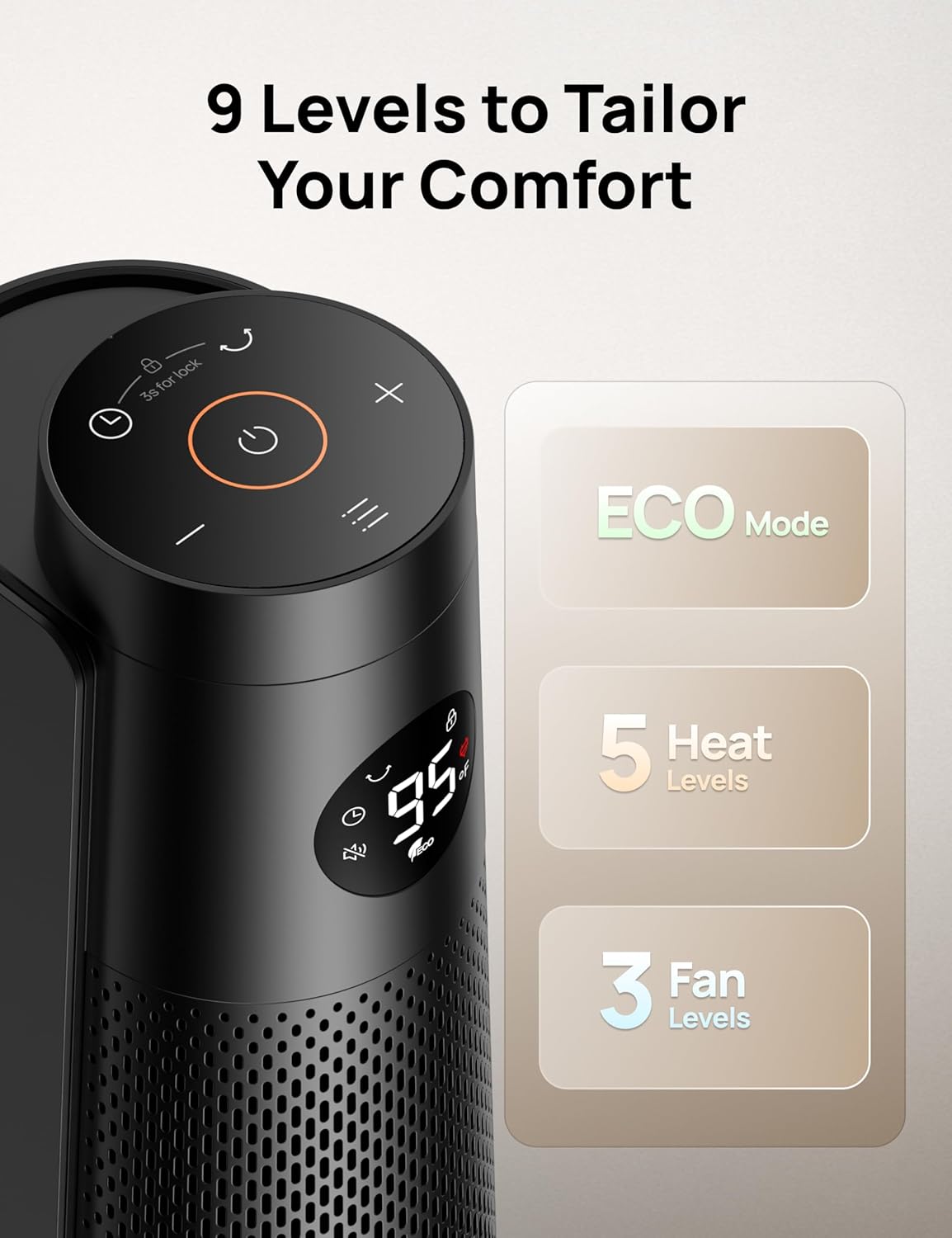
Office Efficiency
I work 9-5 most days. Setting an 8-hour timer when I start work means my Dreo space heater runs during office hours then shuts off automatically when I’m done—even if I forget.
Peace of mind: Ever left for the day worrying you left your heater running? The timer eliminates that anxiety entirely. Set it appropriately, and the unit will shut down whether you remember to or not.
Who Benefits Most from the Dreo Space Heater?
Not everyone needs premium supplemental heating, but if you fall into these categories, the Dreo space heater might transform your winter experience.
Remote Workers and Home Office Professionals
This is my category, and the Dreo solved my exact pain point. If you spend 8+ hours daily in a home office, zone heating with a quality Dreo space heater provides:
- Focused comfort in your workspace without heating unused rooms
- Whisper-quiet operation that won’t disrupt calls or recordings
- Precise temperature control for all-day productivity
- Significant energy cost reduction versus whole-home heating
Large Room Occupants
Living rooms, master bedrooms, finished basements—spaces exceeding 250 square feet challenge most space heaters. The Dreo’s 300 square foot coverage and 120° oscillation actually handle these areas effectively.
Bonus advantage: The powerful output means you can heat large spaces without running on maximum constantly. Using Level 3-4 heating in a big room is quieter, more efficient, and less stressful on the unit than maxing out a weaker heater.
Safety-Conscious Households
If you have children, pets, or elderly family members, the eight-layer safety system provides genuine peace of mind. I stopped worrying about my Dreo space heater within days of ownership—the comprehensive protections work seamlessly and reliably.
Light Sleepers Who Need Nighttime Warmth
The 25dB operation makes overnight bedroom heating actually viable. I’m a notoriously light sleeper (ceiling fans disturb me), and the Dreo runs silently enough that I genuinely forget it’s operating.
Temperature stability: The precise thermostat control prevents the temperature swings that disrupt sleep. Once my bedroom reaches target temperature, it stays there—no cycling between too hot and too cold.
Energy-Conscious Consumers
If high utility bills stress you out, the Dreo space heater’s ECO mode and precise temperature control deliver measurable savings. My detailed electricity monitoring showed approximately 35-50% energy reduction compared to previous heating methods while maintaining superior comfort.

The Energy Efficiency Deep Dive: Real Numbers, Real Savings
Let’s talk about what matters most—actual operating costs and how the Dreo space heater impacts your wallet.
Power Consumption Breakdown
The Dreo operates at maximum 1500W, standard for space heaters in this class. But raw wattage tells only part of the story—efficiency determines actual costs.
Operating cost at $0.13/kWh (national average):
- Maximum power (1500W): $0.195 per hour
- Medium power (~1000W): $0.13 per hour
- ECO mode (variable): $0.08-0.15 per hour depending on demand
My Real-World Usage and Costs
I track energy consumption obsessively. Here’s my actual Dreo space heater usage over three winter months:
Typical daily pattern:
- 2 hours morning (ECO mode): ~$0.20
- 8 hours workday (ECO mode): ~$0.90
- 2 hours evening (medium power): ~$0.26
Daily total: ~$1.36 Monthly total: ~$40.80
The Comparison That Matters
Before implementing zone heating with my Dreo, I ran central heating to keep my office comfortable. My winter heating bills averaged $210-240 monthly.
After switching to baseline central heating (62°F) plus Dreo zone heating:
- Central heating cost: ~$90-110 monthly
- Dreo operation: ~$40 monthly
- Total: ~$130-150 monthly
Net savings: $60-90 monthly, or $240-360 per heating season
The Dreo space heater paid for itself within two months. Everything after that is pure savings.
Installation and Setup: The Five-Minute Reality
I’m not particularly handy. Complicated setup frustrates me quickly. The Dreo requires zero installation skill.
Out-of-Box to Operating Heat
Step 1: Remove from packaging (2 minutes) Step 2: Attach base plate with included screws (2 minutes)
Step 3: Plug into wall outlet (10 seconds) Step 4: Power on and set preferences (1 minute)
Total time: 5 minutes maximum
Placement Optimization Tips
Where you position your Dreo space heater dramatically impacts performance:
✅ Do place:
- At least 3 feet from furniture or curtains
- On level, stable surfaces
- Away from high-traffic areas where it might be knocked over
- In corners or along walls for best oscillation coverage
❌ Don’t place:
- Directly under wall-mounted items
- On thick carpeting that blocks bottom vents
- Near bathrooms or other moisture sources
- In enclosed spaces like closets
I position mine in my office corner, about 8 feet from my desk. The 120° oscillation from that position covers my entire workspace beautifully.
Maintenance Reality: What Actually Required
Six months in, here’s the honest maintenance reality for my Dreo space heater.
Weekly Tasks (5 minutes)
Visual inspection for dust buildup around vents. Quick vacuum with brush attachment if necessary. That’s it.
Monthly Deep Clean (15 minutes)
- Unplug completely
- Vacuum all vents thoroughly
- Wipe exterior with damp cloth
- Check remote battery
- Inspect cord for any damage
Seasonal Storage
When heating season ends, I clean thoroughly and store in a closet. Proper storage extends lifespan:
- Store in dry location
- Keep away from direct sunlight
- Don’t stack heavy items on top
- Store remote with batteries removed
Following this simple routine, my Dreo space heater performs like new after six months of heavy daily use.
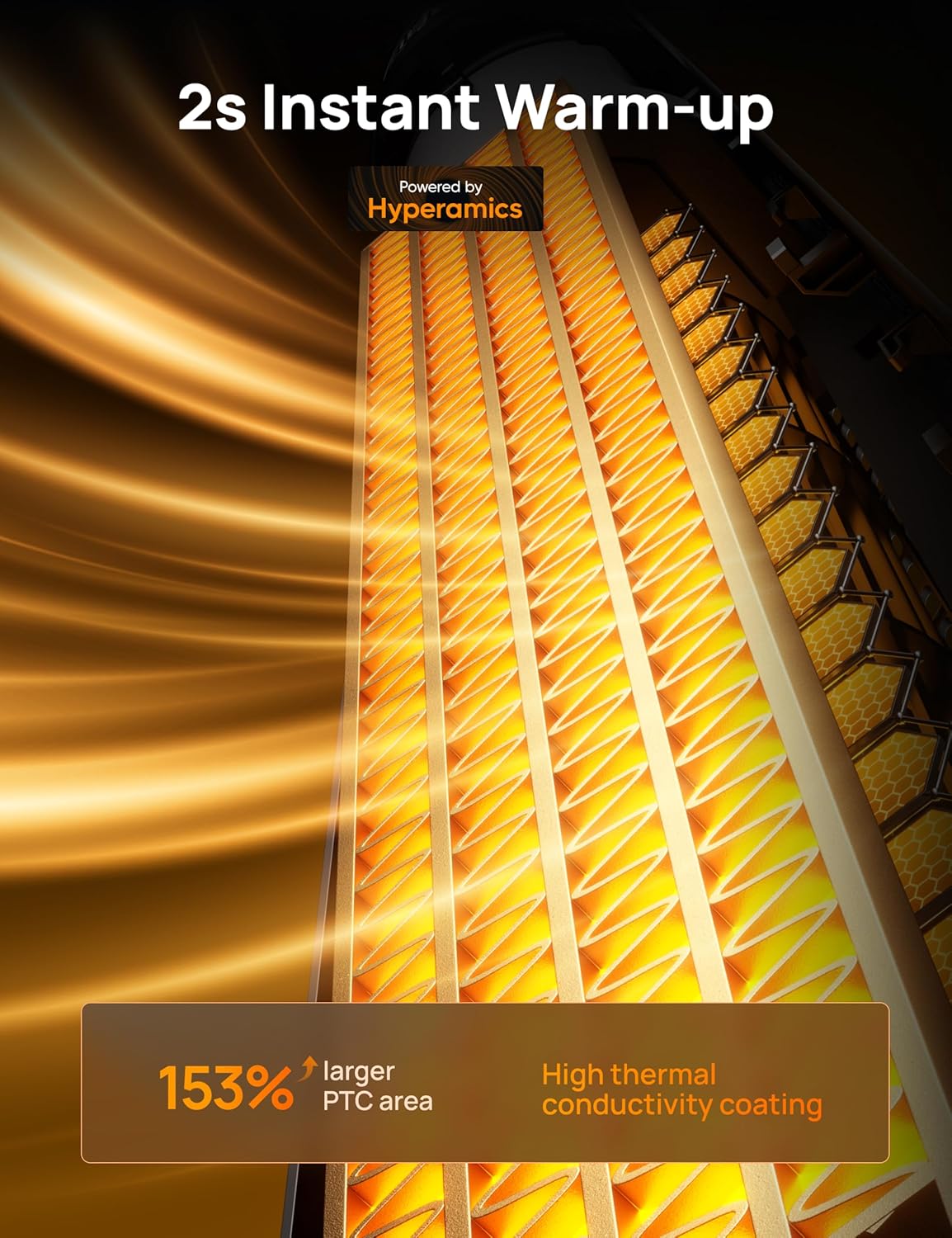
Your Path to Smarter Heating: Making the Decision
You’ve made it this far, which means you’re seriously considering upgrading your heating situation. Let me help you decide if the Dreo space heater matches your specific needs.
The Right Fit Assessment
You should buy this Dreo space heater if:
- You need effective heating for rooms up to 300 square feet
- Quiet operation matters for your work or sleep environment
- You value comprehensive safety features and certifications
- Energy efficiency and cost control are priorities
- You want customizable heating with multiple comfort levels
- Remote control convenience appeals to you
Consider other options if:
- You need to heat spaces larger than 350 square feet regularly
- You’re looking for primary heating, not supplemental warmth
- Budget constraints limit investment in premium features
- You have specific smart home integration requirements
- Portability between floors matters (this unit works best staying in one room)
The Investment Perspective
A quality Dreo space heater represents a meaningful investment in:
- Daily comfort during cold months (immediate value)
- Long-term energy cost reduction (ROI in 1-3 months)
- Safety and peace of mind (priceless)
- Heating flexibility and customization (quality of life)
This isn’t disposable equipment—it’s a tool that improves your living experience season after season while paying for itself through energy savings.

Why I Recommend the Dreo Without Reservation
After six months of daily use through the harshest part of winter, my Dreo space heater remains one of my best home comfort investments.
What matters most to me:
The warmth is immediate and powerful. No waiting around shivering while the heater “warms up”—I feel heat within seconds of powering on.
The silence transformed my work environment. I literally forget it’s running during video calls, which never happened with previous heaters.
The safety features let me relax. I run it unattended, overnight, and during long work sessions without constant anxiety about fire risks.
The energy efficiency is measurably real. My utility bills dropped noticeably, and detailed consumption tracking confirms approximately 40% reduction versus my previous heating methods.
Your Winter Comfort Starts Here
Cold rooms don’t have to mean discomfort or astronomical heating bills. The right Dreo space heater delivers powerful, safe, quiet warmth exactly where you need it—without the waste and expense of whole-home heating.
Since adding mine to my daily routine, I’ve transformed my winter home experience. My workspace stays perfectly comfortable throughout the workday. My bedroom provides consistent sleeping temperature. And my energy bills have dropped significantly.
That combination—superior comfort, comprehensive safety, reduced costs, and effortless operation—makes the Dreo space heater a decision I’d make again without hesitation.

